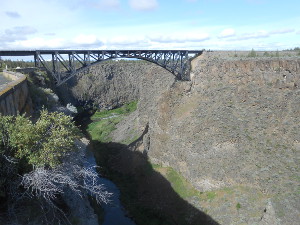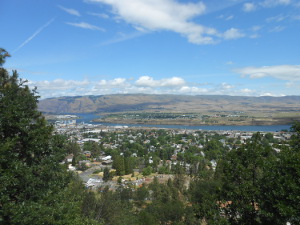We have traveled along the Western coast of Oregon several times,  Crooked River Gorge Bridge
but have crossed the middle of the state much less often. This year we took ourselves right up through the center, past the Crooked River Gorge, with its wonderful old bridge, stopping in The Dalles, on the edge of the Columbia River. The name refers to pillar-like formations of rocks where the river has chewed away at them.
Crooked River Gorge Bridge
but have crossed the middle of the state much less often. This year we took ourselves right up through the center, past the Crooked River Gorge, with its wonderful old bridge, stopping in The Dalles, on the edge of the Columbia River. The name refers to pillar-like formations of rocks where the river has chewed away at them.
We had two interesting days, including some delicious lunches, before heading northeast. Our first day concentrated on the Columbia Gorge Discovery Center, which covered the history of the region and also included a presentation of raptors. They have a half-dozen birds, all rescued from the wild where they had been injured. The large bird  The Dalles, Oregon
is the red-tailed hawk, the small one is the kestrel.
The Dalles, Oregon
is the red-tailed hawk, the small one is the kestrel.
Once Oregon Territory was the biggest territory in the Union; also, once Wasco County was the biggest county in Oregon. Both got trimmed down, little by little, over the years. Oregon and California were states before the Civil War started. They didn't secede, they fought for the Union.
At one time there was gold near The Dalles, but that wore out, after seven million dollars of gold had been taken. Then there were sheep ranches nearby, but the price of wool dropped and cattle now take preference. But there has always been golden wheat on the  Columbia Gorge Discovery Center
hillsides near The Dalles, and even today the wheat is packed on boats and shipped to Asia for noodles.
Columbia Gorge Discovery Center
hillsides near The Dalles, and even today the wheat is packed on boats and shipped to Asia for noodles.
The worst story, locally, about the Columbia River gorge, is the building of the dam at The Dalles, which drowned an ancient-but-still-occupied Indian village, an old trading center, where the Indians traditionally caught the salmon each spring. Uncle Sam let the Indians down again, and locals remember the event with at best mixed feelings, at worst anger against the unfeeling BIA and Corps of Engineers.
On our second day we visited the local history museum. Fort  Red-tailed Hawk
Dalles dates back to 1854, when Colonel Wright was dispatched to deal with (read violently suppress) the local Indians. He went on to command the Presidio in San Francisco. The orginal Surgeon's quarters is still standing, as is the headquarters for the museum, which dates to 1910. We had a guided tour by a docent who told us a lot about the life and times, including the Anderson house. He was a prosperous Swedish immigrant who married a Norwegian woman and eventually settled here. The old furnishings were quite remarkable.
Red-tailed Hawk
Dalles dates back to 1854, when Colonel Wright was dispatched to deal with (read violently suppress) the local Indians. He went on to command the Presidio in San Francisco. The orginal Surgeon's quarters is still standing, as is the headquarters for the museum, which dates to 1910. We had a guided tour by a docent who told us a lot about the life and times, including the Anderson house. He was a prosperous Swedish immigrant who married a Norwegian woman and eventually settled here. The old furnishings were quite remarkable.
Leaving The Dalles, we crossed the Columbia River and followed Washington Route 14 along the north shore of the Columbia, a very  Guide holding kestrel
beautiful ride. We stopped at overlooks, took pictures one way and t'other, loved the treeless hills along the river with the volcanic outcroppings and steep rocky faces. At one point we could see Mount Hood in the distance over the Columbia River.
Guide holding kestrel
beautiful ride. We stopped at overlooks, took pictures one way and t'other, loved the treeless hills along the river with the volcanic outcroppings and steep rocky faces. At one point we could see Mount Hood in the distance over the Columbia River.
In Wishram we saw a truly humungous locomotive and attached water car to keep a huge steam boiler working and pulling big trains. The unit weighed 365,000 pounds and was built in 1923 and retired in 1955, when the new diesels proved too cost-effective. Today it's covered in a big shed with a fence around, by people who love trains.
As we neared Umatilla, Oregon, Bob spotted a funny looking  The Surgeon's Quarters
cloud in the distance, and successfully identified it as a nascent grass fire. While we had an excellent lunch in Umatilla, the local radio newsreader said the interstate was closed because the fire was too close. Glad we weren't going that way.
The Surgeon's Quarters
cloud in the distance, and successfully identified it as a nascent grass fire. While we had an excellent lunch in Umatilla, the local radio newsreader said the interstate was closed because the fire was too close. Glad we weren't going that way.
One of the most important things about Native Americans and First Nations is that the members do have a strong sense of community, something that many other Americans are lacking.
The community of a Native American tribe extends back into distant memory, long before contact with Europeans. This is a more ancient memory than even Mayflower descendants can boast.
Although the road to the present is bloody and stricken with disease and poverty, Indians still have reservations over which they exercise sovereignty, and descendants are welcome to return to these reservations and (re)join the community.
 Mount Hood over the Columbia
Mount Hood over the Columbia
We visited the Tamastslikt Cultural Institute, on the Umatilla Reservation, representing the Cayuse, Umatilla, and Walla Walla tribes on the Columbia River Plateau. They had an ancient history of subsistence on this land, moving around in an annual cycle to take advantage of different foods, chief of which was the salmon.
They didn't get horses until 1730, when they met the Shoshones and gave up everything they had for a stallion and a mare. By 1800 their local Cayuse horses, which they bred by the hundreds and thousands, were in demand all over the West.
But the waves of settlement and commerce came west and took  Grass fire
their best land, shrinking their reservation over and over, leaving the steep canyons and badlands.
Grass fire
their best land, shrinking their reservation over and over, leaving the steep canyons and badlands.
But somehow they have endured, thrown off the evil memories of the BIA schools which tried their damndest to cure them of being Indian, forbade their language and customs.
Now, it seems, the annual Pendleton Roundup is different from all other western rodeos, because this is when the tribes come out, even the ones working in town put on their best ceremonial finery and pour out onto the rodeo grounds demonstrating their still-surviving and oh, so powerful sense of community.
 Tamastslikt Cultural Center
Tamastslikt Cultural Center
Yes, we liked the museum, very much. No pictures, as they were prohibited, but we read the monthly paper, which told us that members of the tribe won two of the one thousand coveted Gates Scholarships this year. There was a great deal of evidence that told us that the reservation is recovering, planning to buy back land within their boundaries that had passed into private ownership. Outside the museum, the puffy white clouds in the sky made a nice contrast with the greensward planted near the stone and wood sides of the tribal museum.
So if your travels take you that way, consider visiting this museum. There's a golf course, hotel, and casino nearby, but the museum is the cat's meow!
 Crooked River Gorge Bridge
but have crossed the middle of the state much less often. This year we took ourselves right up through the center, past the Crooked River Gorge, with its wonderful old bridge, stopping in The Dalles, on the edge of the Columbia River. The name refers to pillar-like formations of rocks where the river has chewed away at them.
Crooked River Gorge Bridge
but have crossed the middle of the state much less often. This year we took ourselves right up through the center, past the Crooked River Gorge, with its wonderful old bridge, stopping in The Dalles, on the edge of the Columbia River. The name refers to pillar-like formations of rocks where the river has chewed away at them.
 The Dalles, Oregon
The Dalles, Oregon Columbia Gorge Discovery Center
Columbia Gorge Discovery Center Red-tailed Hawk
Red-tailed Hawk Guide holding kestrel
Guide holding kestrel The Surgeon's Quarters
The Surgeon's Quarters Mount Hood over the Columbia
Mount Hood over the Columbia Grass fire
Grass fire Tamastslikt Cultural Center
Tamastslikt Cultural Center